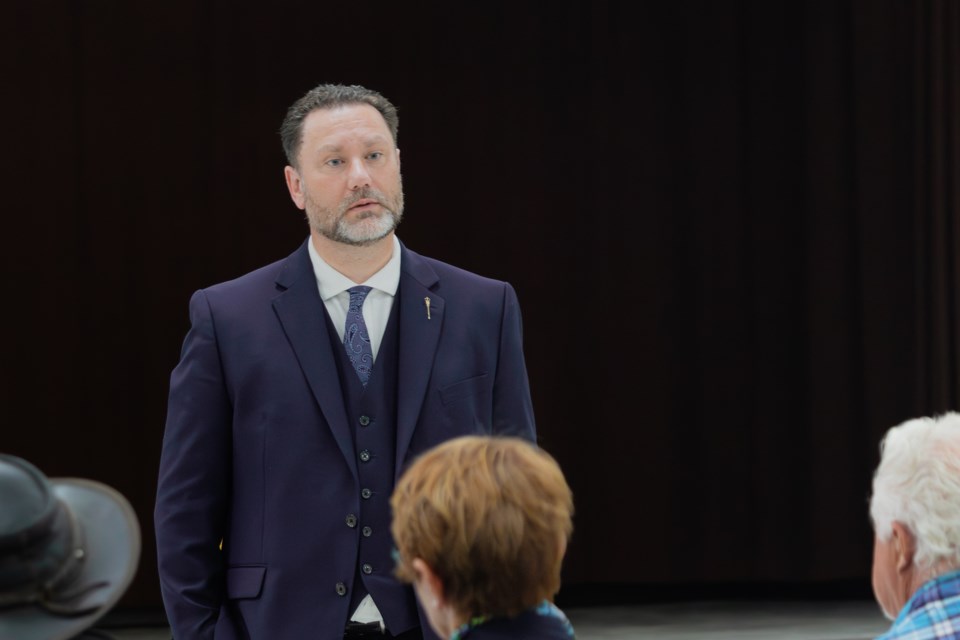ST. PAUL – Senior care in St. Paul remains a major priority for Bonnyville-Cold Lake-St. Paul MLA Scott Cyr, who held a town hall meeting in St. Paul on July 16 to discuss community concerns.
The meeting was part of a series of town halls Cyr scheduled in the Lakeland area this month, which also included stops in Elk Point, Bonnyville, and Cold Lake.
Yvonne Weinmeier, executive director for the St. Paul and District Chamber of Commerce, said seniors in St. Paul sometimes do not have anywhere to go to. “We’re having difficulties dealing with aging parents.”
Cyr acknowledged the issue and one of the improvements made was bringing contracted home care, like Apidae Compassion Care, to the Lakeland in the spring of 2024.
“We always had home care, but not contracted,” he said, explaining the idea is to help seniors stay at home longer, before moving on to long-term care.
But more work needs to be done, acknowledged Cyr, such as potentially expanding contracted home care for seniors to help alleviate pressure throughout the region.
St. Paul Regional FCSS Director Brenda Billo agreed that contracted home care is important but pointed out many seniors or their family members “can’t afford it.”
She said while there is a subsidized home care program through the Alberta government to help cover costs, clients need a referral from their local home care unit, but seniors in St. Paul are not getting those referrals approved or transferred properly.
Cyr said he will follow up on the issue.
Lack of space
The MLA also said senior care is a regional issue due to proximity of municipalities in the Lakeland, with long-term care facilities taking in seniors from different municipalities.
He said improving care in Bonnyville in particular is crucial to increasing the level of care in the region. “Once we’ve dealt with Bonnyville, it’s going to take pressure off of all of the region,” he said.
“Everybody’s saying we need more long-term care spaces in all of the region. Actually, we don’t,” he explained. “We have one municipality that is taking up all the action for all the ones around it.”
One problem that needs to be addressed in Bonnyville, according to the MLA, is improving the Bonnyville Extendicare building.
“It’s not unsafe,” he said. “But I will say that we’re . . . jamming a whole lot of people into tight spaces.”
He said he is also working to push forward the possibility of adding another long-term care facility in Bonnyville.
“Our long-term care is acting as bed blockers right now. If I fix the long-term care, then I'm going to find other bottlenecks in the system that we can look to address. But right now, for our region, long-term care in Bonnyville is the biggest problem,” said Cyr.
Edna Gervais, a resident of St. Paul and also a director with the St. Paul and District Chamber of Commerce, said acute care for seniors is also a problem in St. Paul.
Weinmeier expressed similar sentiments. “I believe our second floor [at the hospital] . . . is full of people that could be in long-term care versus taking up a hospital bed,” she said.
Cyr agreed, noting the hospital’s second floor has four people per room for both genders. “So, that’s awkward,” he said.
The MLA added he would want the third floor of the hospital utilized for acute care, believing the floor is fully outfitted for the service. “Why is it that? That floor isn’t being used for our acute care?”
“We could go with two per room, instead of four per room that we’re doing right now,” he said, adding he is continuing to work on the issue, in addition to adding a CT scanner at the hospital, which he said is another priority for him.
Increased utility costs
One way to alleviate challenges in senior care is to encourage seniors to stay in their own homes, said Cyr, which would help take pressure off seniors’ facilities.
But increasing utility costs is a growing problem, not only for rural Albertans in general, but seniors as well, many of whom are unable to pay their bills.
“So, utilities are definitely a hardship that we need to deal with, and I’m pushing on that now,” Cyr said. This involves addressing the structure of utility fees to make them more equitable for rural residents, especially in northern parts of the province.
According to Cyr, there are two types of utilities fees - transmission and distribution.
Transmission fees cover the big power lines that move electricity across Alberta, and everyone pays the same for that. Distribution fees cover the local lines that deliver power within a service area to homes and businesses.
“It’s the distribution fees,” which make up a large part of a northern Albertan’s utility bill, according to Cyr.
In rural areas, where customers are far apart, it costs more to maintain local lines, and those costs are passed on to residents.
“Distribution fees are unfair, and it unfairly puts a strain on the residents in the north zone . . . We're literally building industry up on the backs of residents right now. And that's a real problem.”
According to the MLA, the oil and gas industry, many of which are located in northern Alberta, contributes about $19 billion in royalties to the province, but he suggested that Edmonton and Calgary are receiving most of those royalties, which is a concern for him.
“Our distribution fees should be pooled just the same way as transmission [fees],” he said.
According to Cyr, he’s received calls from seniors who have received high utility bills, exceeding $1,000.
“It’s heartbreaking,” he said. “This needs to be fixed.”



